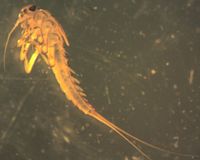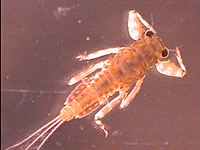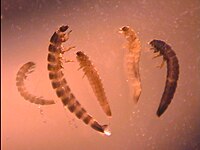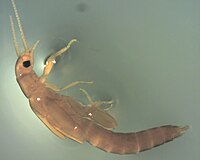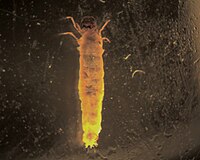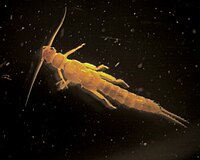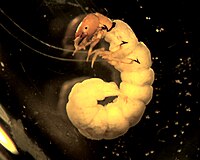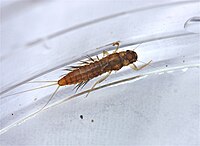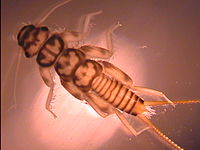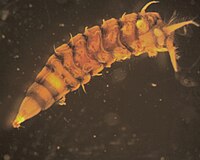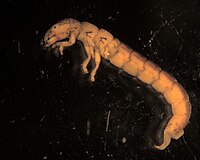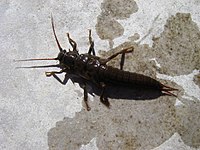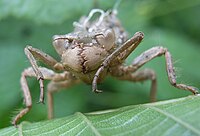Vermont EPSCoR's Streams Project; A Teacher Collaboration on WikiEducator
Openly shared content, practices, and developing resources from Vermont EPSCoR's Streams Project. Join this collaboration and make a difference!
 Dowsville Brook |
|---|
|
| Basin: | Winooski |
| State or Province: | Vermont |
| Country: | USA |
| Latitude: | 44.24091 |
| Longitude: | -72.774834 |
| School: | Harwood Union High School |
The following are the most common invertebrates collected from this stream site.
List of taxa found is from VT DEC and we thank them for their work in sampling and identification. The taxa listed below represent about 90% of the organisms likely to be found in this stream.
Taxa listed in red are those for which we have not yet made a template. Please leave them on the page and once templates have been made they will automatically update the page.
Chironomidae
- Order
- Diptera
- Family
- Chironomidae
- Common name
- Nonbiting midge
- Tied fly
- Griffith's Gnat
Midge larvae tend to be the most common macroinvertebrate at our sites. As with other Diptera, there are no true jointed legs. Chironomidae do have a pair of prolegs at each end and preserved individuals tend to curl into a 'C'. Identification past family requires slide-mounted heads. We have seen philopotamid caddisflies misidentified with the chironomids and we suspect that that happens when samples are being sorted from trays. Under a microscope, six prominent legs can be seen on members of the caddisfly family Philopotamidae.
More information on Philopotamidae.
Baetis
- Order
- Ephemeroptera
- Family
- Baetidae
- Genus
- Baetis
- Common name
- The Little Olive
- Tied fly
- Sawyer Pheasant Tail Nymph
This mayfly has three "tails" and a unique head shape. Its gills are oval shaped and insert dorsally. More mature nymphs have long, dark wing pads.
Image of the long, dark wing pads.
Ephemerella
- Order
- Ephemeroptera
- Family
- Ephemerellidae
- Genus
- Ephemerella
- Common name
- The Hendrickson; The Red Quill; The Hendrickson Spinner Fall
- Tied fly
- Hendrickson; Flick's Red Quill; Lunn's Particular
Mayflies in this genus have long intersegmental setae on their cerci that extend laterally and may or may not have whorls of spines at the end of each segment of their cerci. Their maxillary palps are well-developed.
Image of the intersegmental setae.
Elmidae
- Order
- Coleoptera
- Family
- Elmidae
- Common name
- riffle beetle
We very commonly find adult and larval riffle beetles. The adults are clearly beetles, but the larvae can be confused with other orders. The forward pointing tooth on the front end of the larvae as described in the key can be a challenge to see, particularly in small individuals. Larvae are characterized by having a single tarsal claw at the end of their legs, which have 4 segments. Adults, on the other hand, have two tarsal claws at the end of each leg. Commonly encountered genera include
Dubiraphia,
Macroychu,
Optioservus,
Phanocerus,
Promoresia, and
Stenelmis.
Images of the adult and larval riffle beetles.
More information on Dubiraphia, Macronychus, Optioservus, Phanocerus, Promoresia, and Stenelmis.
Leuctridae
- Order
- Plecoptera
- Family
- Leuctridae
- Common name
- rolled-winged stoneflies or needle fly
- Tied fly
- Halford's Willow Fly
This family of stonefly is fairly slender by stonefly standards. The divergent wing pads are a helpful characteristic. Leuctridae are similar in overall shape to the Capniidae; however, Leuctridae often do not have pleural folds. If they are present, they only extend from abdominal segments 1-7. The genus
Leuctra are recognized by abdominal terga with posterior fringes of short hairs and last few segments with longer hairs.
Images of the divergent wing pads, Capniidae, abdominal terga and a ventral view can be seen here.
Lepidostomatidae
- Order
- Trichoptera
- Family
- Lepidostomatidae
- Common name
- The Little Plain Brown Sedge
- Tied fly
- Elk Hair Caddis
These have lateral humps on the first abdominal segments, but lack a dorsal hump. The dorsal of the first two thoracic segments are sclerotized. They are frequently found in four-sided cases made of square pieces of detritus.
Images of the first two thoracic segments and the four-sided cases.
Chloroperlidae
- Order
- Plecoptera
- Family
- Chloroperlidae
- Common name
- The Yellow Sally
- Tied fly
- Yellow Sally
Stoneflies from the family Chloroperlidae have cylindrical banded abdomens. When observing their mouthparts, the glossae and paraglossae form a three-pronged (open) notch, and their hind wing pads are parallel (not divergent). Cerci have a vertical fringe of hairs pointing away from the abdomen. Setae on the pronotum are found primarily at the corners.
Dolophilodes
- Order
- Trichoptera
- Family
- Philopotamidae
- Genus
- Dolophilodes
Paraleptophlebia
- Order
- Ephemeroptera
- Family
- Leptophlebiidae
- Genus
- Paraleptophlebia
- Common name
- The Blue Quill
- Tied fly
- Blue Quill
Leptophlebiidae have forked, tufted, or fringed gills.
Paraleptophlebia typically have labrums less than 1/2 as wide as head anteriorly, which is considered "shallow." There are minute spinules present on posterior margins of abdominal terga 1-10.
Image of the forked, tufted, or fringed gills.
Baetidae
- Order
- Ephemeroptera
- Family
- Baetidae
- Common name
- Small minnow mayfly
- Tied fly
- Tiny blue-winged olive
This mayfly has either two or three cerci ("tails") and a unique head shape. Its gills are oval shaped and insert dorsally. Commonly encountered genera include
Acerpenna,
Baetis and
Pseudocloeon.
More information on the genera:
Acerpenna
Baetis
Pseudocloeon
Perlidae
- Order
- Plecoptera
- Family
- Perlidae
- Common name
- The Golden Stonefly Creeper
- Tied fly
- Connecticut Curler
This stonefly is characterized by the three pairs of filamentous gills located on the sides of all three thoracic segments. It is distinguished from the family Pteronarcyidae by the absence of gills on the abdominal segments. Often, the thoracic terga are brightly patterned as pictured, though this is not always the case. Another important feature is that the paraglossae and glossae extend different lengths.
Images of filamentous gills and the family Pteronarcyidae.
Genera commonly encountered in this family include Acroneuria, Agnetina, and Paragnetina. Less commonly, we have found Perlesta.
Very rarely encountered genera include Neoperla and Hansonoperla. If you believe you have found either of these, please send a specimen our way!
Hydropsychidae
- Order
- Trichoptera (caddisfly)
- Family
- Hydropsychidae
- Common name
- net spinning caddisfly
- Tied fly
- Emergent Sparkle Pupa, Vermont Hare's Ear
This family of net-spinning caddisflies is very abundant at several sites. They are important filtering collectors and are quite common at urban and agricultural sites where particles of organic material can be important food resources. Genus-level identification is possible for mature specimens and we will include the genera we found at your site if possible.
When using the key, some features that are challenging to see are the forked trochantin and the paired sclerites in the folds between segments. Other, more easily seen key features include filamentous gills on the abdominal segments and the sclerotization of the dorsal surfaces of all three thoracic segments. Keep in mind that with smaller or more immature specimens, genus-level ID may not be possible.
Commonly found genera include Cheumatopsyche, Ceratopsyche, and Hydropsyche. Less commonly, we have found Arctopsyche and Potamyia.
Images of the forked trochantin and the paired sclerites.
Athericidae
- Order
- Diptera
- Family
- Athericidae
- Common name
- water snipe flies
Members of the family Athericidae have wrinkled bodies with prolegs on the ventral side. Their mandibles- which can be seen by carefully cutting the head open- move parallel to each other. On the end of their abdomen there are two lobes fringed with setae. Our collections include just the single genus Atherix.
Image of the two lobes of the abdomen.
Polycentropus
- Order
- Trichoptera
- Family
- Polycentropodidae
- Genus
- Polycentropus
The most common genus we encounter is
Polycentropus. These caseless caddisflies frequently have speckled or freckled heads. The anal proleg typically has a prominent black X, although it can in some specimens appear to be a little faded. They are common at Oakledge Park in Lake Champlain, where we also find an additional genus in the same family:
Nyctiophylax.
Click to see the speckled or freckled heads or the prominent black X.
Pteronarcys
- Order
- Plecoptera
- Family
- Pteronarcyidae
- Genus
- Pteronarcys
- Common name
- The Giant Stonefly
- Tied fly
- Kaufmann's Black Stone
Pteronarcyidae have branching gills from the bases of their legs as does
Perlidae. What distinguishes Pteronarcyidae from Perlidae is the presence of gills on the first two abdominal segments. There are only two genera in this family, but the other,
Pteronarcella, is only found in the west/southwest.
Click to see an example of Perlidae or the gills on the first two abdominal segments.
Cordulegastridae
- Order
- Odonata
- Family
- Cordulegastridae
- Common name
- spiketail dragonflies
Like other Odonata, members of this family have four wingpads. Like members of the sub-order Anisoptera, the abdomen terminates in five points. A spoon-shaped mouthpart under the head with large teeth that join along the midline distinguish Cordulegastridae from other dragonfly larvae. This family contains the single genus Cordulegaster.
This stream is unusually diverse. In addition to the invertebrates photographed we also find the following genera: Sweltsa, Lepidostoma, Oulimnius, Taenionema


